Comprehensive Analysis of Business Operations and Strategies
VerifiedAdded on 2023/01/11
|10
|2448
|64
Report
AI Summary
This report provides a comprehensive analysis of business operations, encompassing various critical aspects essential for success. It begins with an introduction to different business sectors and organizational structures, emphasizing the importance of accounting in business planning, budgeting, and cost monitoring. The report delves into the functions of the HR department, including training, recruitment, employee relations, and compliance, while also examining key features of employment legislation. Furthermore, it presents and interprets key accounting information through the use of Profit and Loss (P&L) accounts, illustrating financial performance. The report also explores team development stages, individual roles within teams, motivational theories such as Maslow's and Herzberg's, and different leadership styles. Finally, it concludes by summarizing the key findings and their implications for business operations.
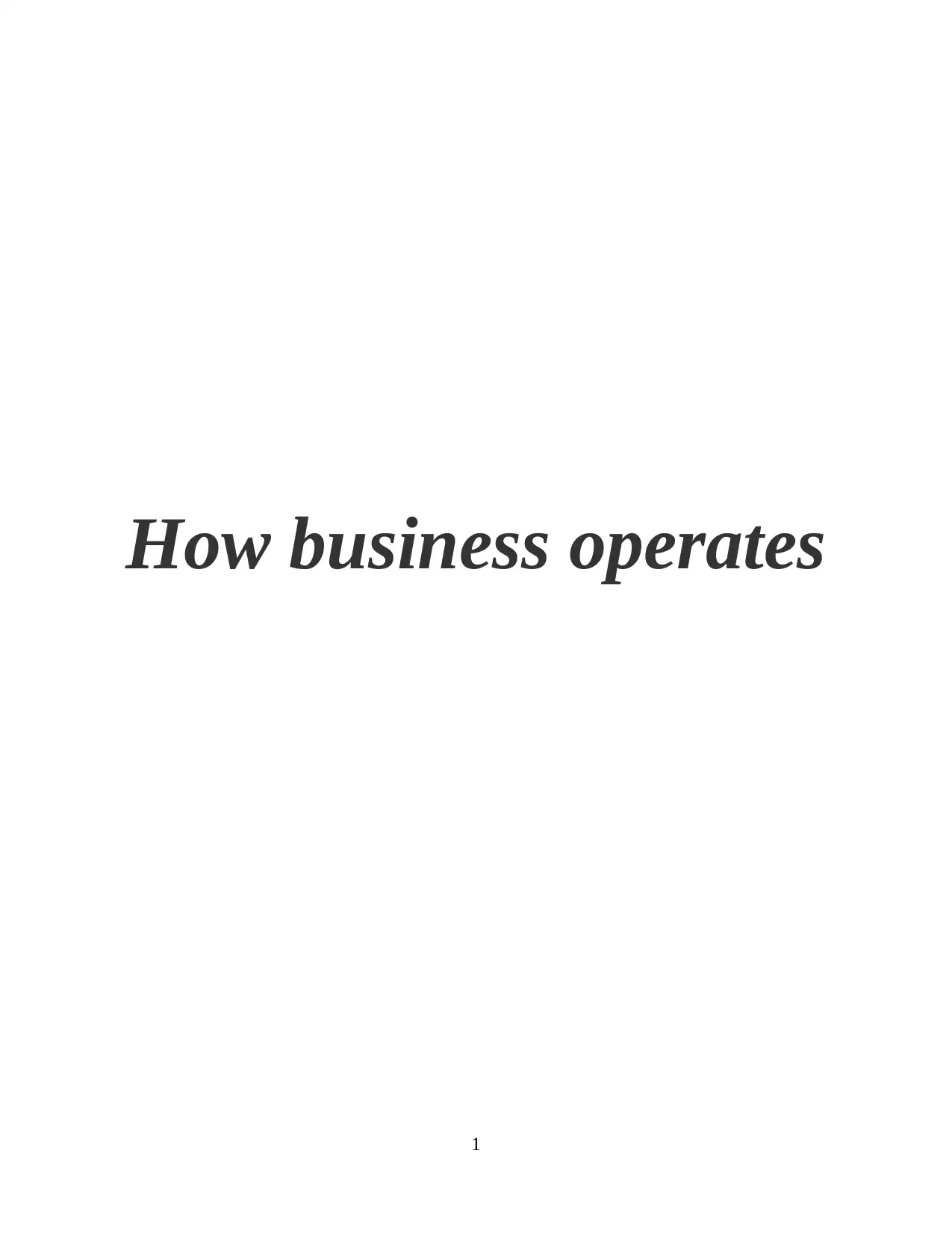
How business operates
1
1
Paraphrase This Document
Need a fresh take? Get an instant paraphrase of this document with our AI Paraphraser
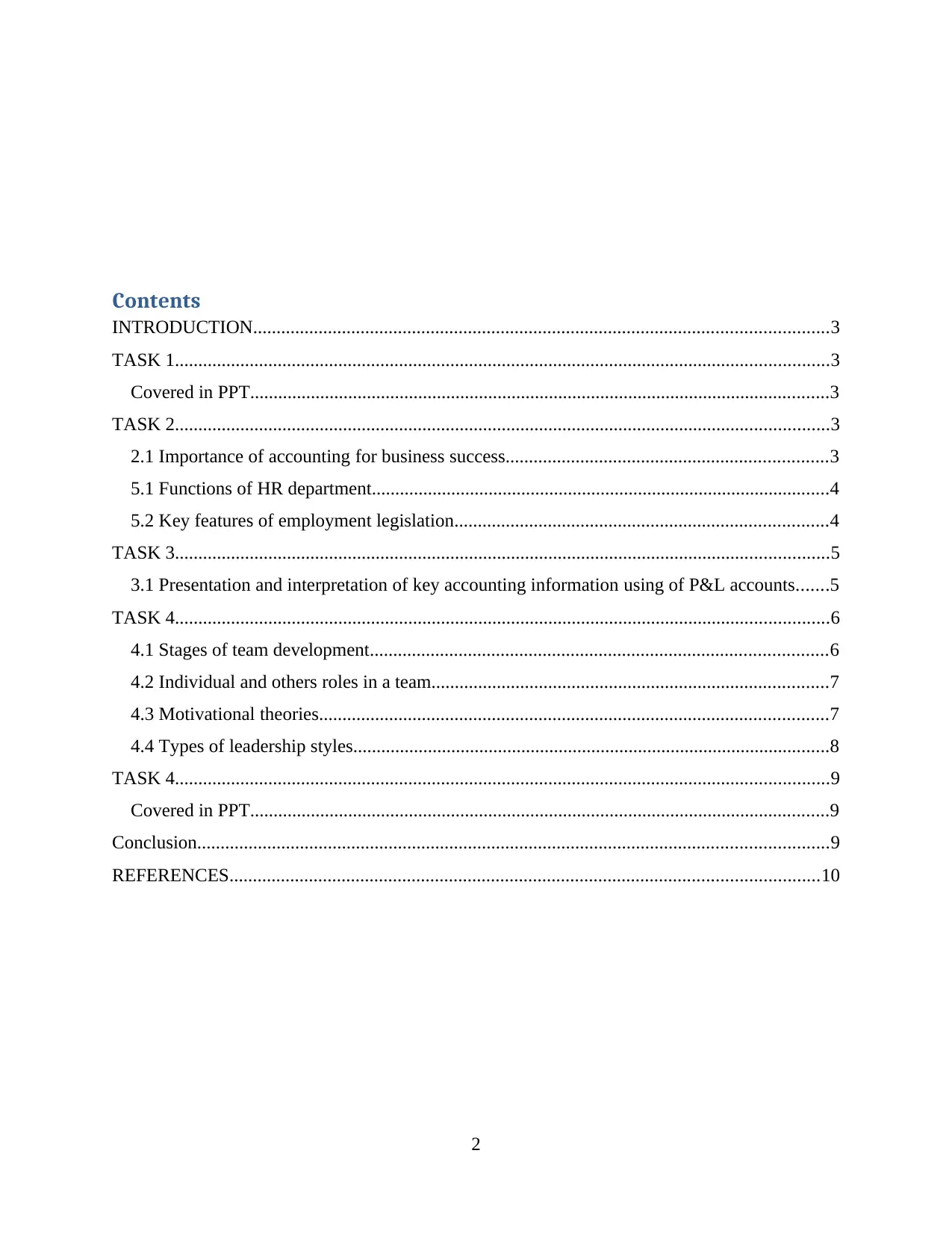
Contents
INTRODUCTION...........................................................................................................................3
TASK 1............................................................................................................................................3
Covered in PPT............................................................................................................................3
TASK 2............................................................................................................................................3
2.1 Importance of accounting for business success.....................................................................3
5.1 Functions of HR department..................................................................................................4
5.2 Key features of employment legislation................................................................................4
TASK 3............................................................................................................................................5
3.1 Presentation and interpretation of key accounting information using of P&L accounts.......5
TASK 4............................................................................................................................................6
4.1 Stages of team development..................................................................................................6
4.2 Individual and others roles in a team.....................................................................................7
4.3 Motivational theories.............................................................................................................7
4.4 Types of leadership styles......................................................................................................8
TASK 4............................................................................................................................................9
Covered in PPT............................................................................................................................9
Conclusion.......................................................................................................................................9
REFERENCES..............................................................................................................................10
2
INTRODUCTION...........................................................................................................................3
TASK 1............................................................................................................................................3
Covered in PPT............................................................................................................................3
TASK 2............................................................................................................................................3
2.1 Importance of accounting for business success.....................................................................3
5.1 Functions of HR department..................................................................................................4
5.2 Key features of employment legislation................................................................................4
TASK 3............................................................................................................................................5
3.1 Presentation and interpretation of key accounting information using of P&L accounts.......5
TASK 4............................................................................................................................................6
4.1 Stages of team development..................................................................................................6
4.2 Individual and others roles in a team.....................................................................................7
4.3 Motivational theories.............................................................................................................7
4.4 Types of leadership styles......................................................................................................8
TASK 4............................................................................................................................................9
Covered in PPT............................................................................................................................9
Conclusion.......................................................................................................................................9
REFERENCES..............................................................................................................................10
2
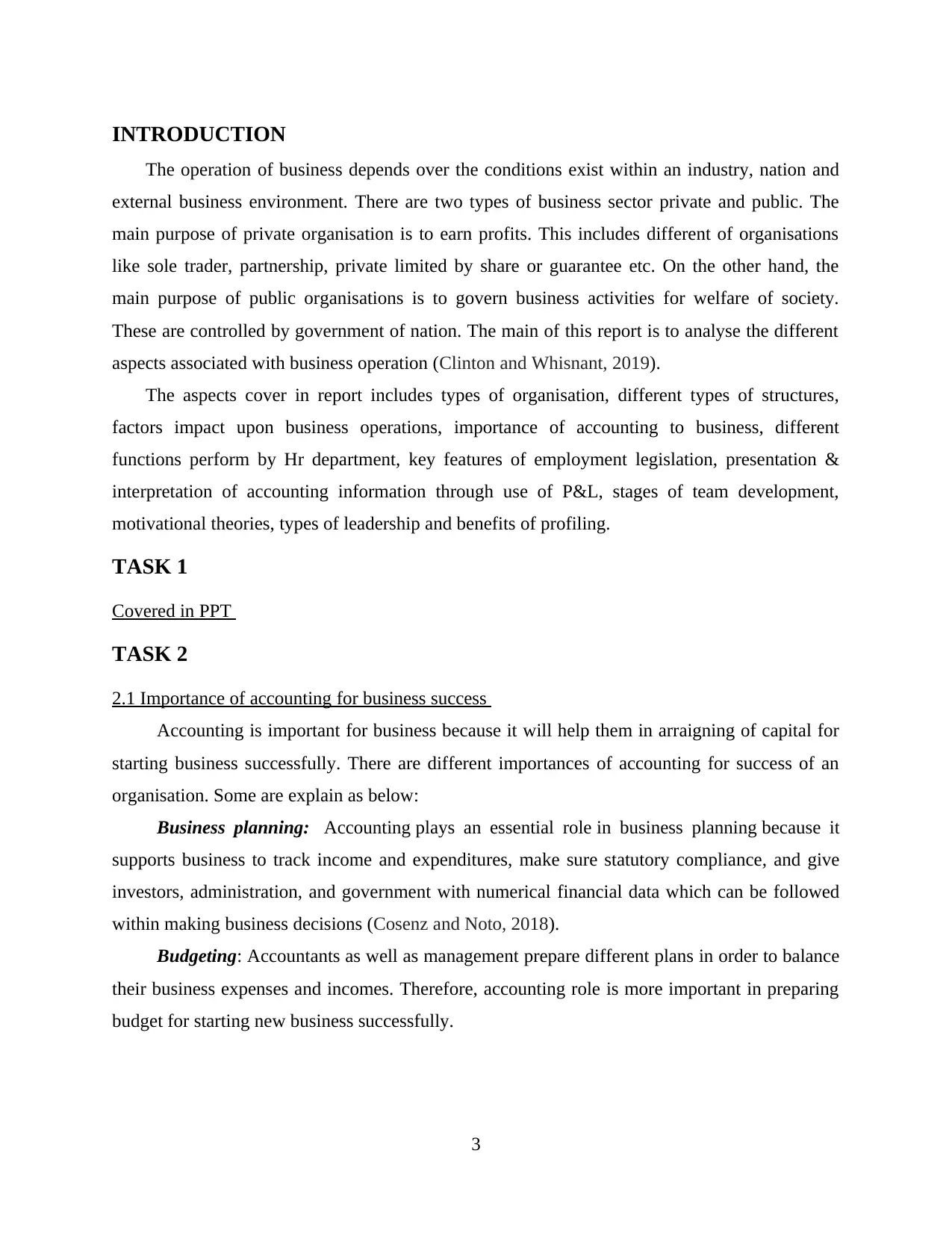
INTRODUCTION
The operation of business depends over the conditions exist within an industry, nation and
external business environment. There are two types of business sector private and public. The
main purpose of private organisation is to earn profits. This includes different of organisations
like sole trader, partnership, private limited by share or guarantee etc. On the other hand, the
main purpose of public organisations is to govern business activities for welfare of society.
These are controlled by government of nation. The main of this report is to analyse the different
aspects associated with business operation (Clinton and Whisnant, 2019).
The aspects cover in report includes types of organisation, different types of structures,
factors impact upon business operations, importance of accounting to business, different
functions perform by Hr department, key features of employment legislation, presentation &
interpretation of accounting information through use of P&L, stages of team development,
motivational theories, types of leadership and benefits of profiling.
TASK 1
Covered in PPT
TASK 2
2.1 Importance of accounting for business success
Accounting is important for business because it will help them in arraigning of capital for
starting business successfully. There are different importances of accounting for success of an
organisation. Some are explain as below:
Business planning: Accounting plays an essential role in business planning because it
supports business to track income and expenditures, make sure statutory compliance, and give
investors, administration, and government with numerical financial data which can be followed
within making business decisions (Cosenz and Noto, 2018).
Budgeting: Accountants as well as management prepare different plans in order to balance
their business expenses and incomes. Therefore, accounting role is more important in preparing
budget for starting new business successfully.
3
The operation of business depends over the conditions exist within an industry, nation and
external business environment. There are two types of business sector private and public. The
main purpose of private organisation is to earn profits. This includes different of organisations
like sole trader, partnership, private limited by share or guarantee etc. On the other hand, the
main purpose of public organisations is to govern business activities for welfare of society.
These are controlled by government of nation. The main of this report is to analyse the different
aspects associated with business operation (Clinton and Whisnant, 2019).
The aspects cover in report includes types of organisation, different types of structures,
factors impact upon business operations, importance of accounting to business, different
functions perform by Hr department, key features of employment legislation, presentation &
interpretation of accounting information through use of P&L, stages of team development,
motivational theories, types of leadership and benefits of profiling.
TASK 1
Covered in PPT
TASK 2
2.1 Importance of accounting for business success
Accounting is important for business because it will help them in arraigning of capital for
starting business successfully. There are different importances of accounting for success of an
organisation. Some are explain as below:
Business planning: Accounting plays an essential role in business planning because it
supports business to track income and expenditures, make sure statutory compliance, and give
investors, administration, and government with numerical financial data which can be followed
within making business decisions (Cosenz and Noto, 2018).
Budgeting: Accountants as well as management prepare different plans in order to balance
their business expenses and incomes. Therefore, accounting role is more important in preparing
budget for starting new business successfully.
3
⊘ This is a preview!⊘
Do you want full access?
Subscribe today to unlock all pages.

Trusted by 1+ million students worldwide
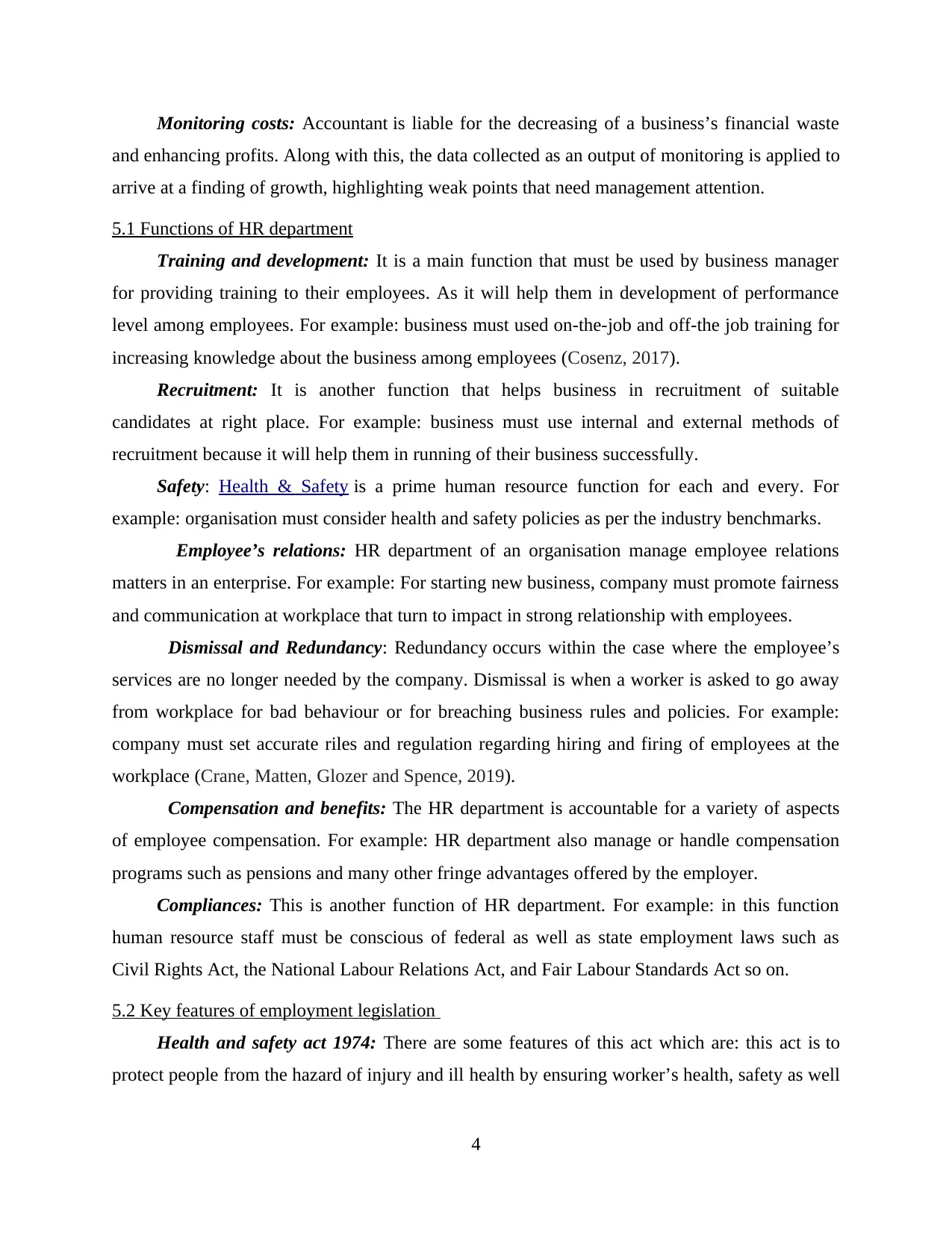
Monitoring costs: Accountant is liable for the decreasing of a business’s financial waste
and enhancing profits. Along with this, the data collected as an output of monitoring is applied to
arrive at a finding of growth, highlighting weak points that need management attention.
5.1 Functions of HR department
Training and development: It is a main function that must be used by business manager
for providing training to their employees. As it will help them in development of performance
level among employees. For example: business must used on-the-job and off-the job training for
increasing knowledge about the business among employees (Cosenz, 2017).
Recruitment: It is another function that helps business in recruitment of suitable
candidates at right place. For example: business must use internal and external methods of
recruitment because it will help them in running of their business successfully.
Safety: Health & Safety is a prime human resource function for each and every. For
example: organisation must consider health and safety policies as per the industry benchmarks.
Employee’s relations: HR department of an organisation manage employee relations
matters in an enterprise. For example: For starting new business, company must promote fairness
and communication at workplace that turn to impact in strong relationship with employees.
Dismissal and Redundancy: Redundancy occurs within the case where the employee’s
services are no longer needed by the company. Dismissal is when a worker is asked to go away
from workplace for bad behaviour or for breaching business rules and policies. For example:
company must set accurate riles and regulation regarding hiring and firing of employees at the
workplace (Crane, Matten, Glozer and Spence, 2019).
Compensation and benefits: The HR department is accountable for a variety of aspects
of employee compensation. For example: HR department also manage or handle compensation
programs such as pensions and many other fringe advantages offered by the employer.
Compliances: This is another function of HR department. For example: in this function
human resource staff must be conscious of federal as well as state employment laws such as
Civil Rights Act, the National Labour Relations Act, and Fair Labour Standards Act so on.
5.2 Key features of employment legislation
Health and safety act 1974: There are some features of this act which are: this act is to
protect people from the hazard of injury and ill health by ensuring worker’s health, safety as well
4
and enhancing profits. Along with this, the data collected as an output of monitoring is applied to
arrive at a finding of growth, highlighting weak points that need management attention.
5.1 Functions of HR department
Training and development: It is a main function that must be used by business manager
for providing training to their employees. As it will help them in development of performance
level among employees. For example: business must used on-the-job and off-the job training for
increasing knowledge about the business among employees (Cosenz, 2017).
Recruitment: It is another function that helps business in recruitment of suitable
candidates at right place. For example: business must use internal and external methods of
recruitment because it will help them in running of their business successfully.
Safety: Health & Safety is a prime human resource function for each and every. For
example: organisation must consider health and safety policies as per the industry benchmarks.
Employee’s relations: HR department of an organisation manage employee relations
matters in an enterprise. For example: For starting new business, company must promote fairness
and communication at workplace that turn to impact in strong relationship with employees.
Dismissal and Redundancy: Redundancy occurs within the case where the employee’s
services are no longer needed by the company. Dismissal is when a worker is asked to go away
from workplace for bad behaviour or for breaching business rules and policies. For example:
company must set accurate riles and regulation regarding hiring and firing of employees at the
workplace (Crane, Matten, Glozer and Spence, 2019).
Compensation and benefits: The HR department is accountable for a variety of aspects
of employee compensation. For example: HR department also manage or handle compensation
programs such as pensions and many other fringe advantages offered by the employer.
Compliances: This is another function of HR department. For example: in this function
human resource staff must be conscious of federal as well as state employment laws such as
Civil Rights Act, the National Labour Relations Act, and Fair Labour Standards Act so on.
5.2 Key features of employment legislation
Health and safety act 1974: There are some features of this act which are: this act is to
protect people from the hazard of injury and ill health by ensuring worker’s health, safety as well
4
Paraphrase This Document
Need a fresh take? Get an instant paraphrase of this document with our AI Paraphraser
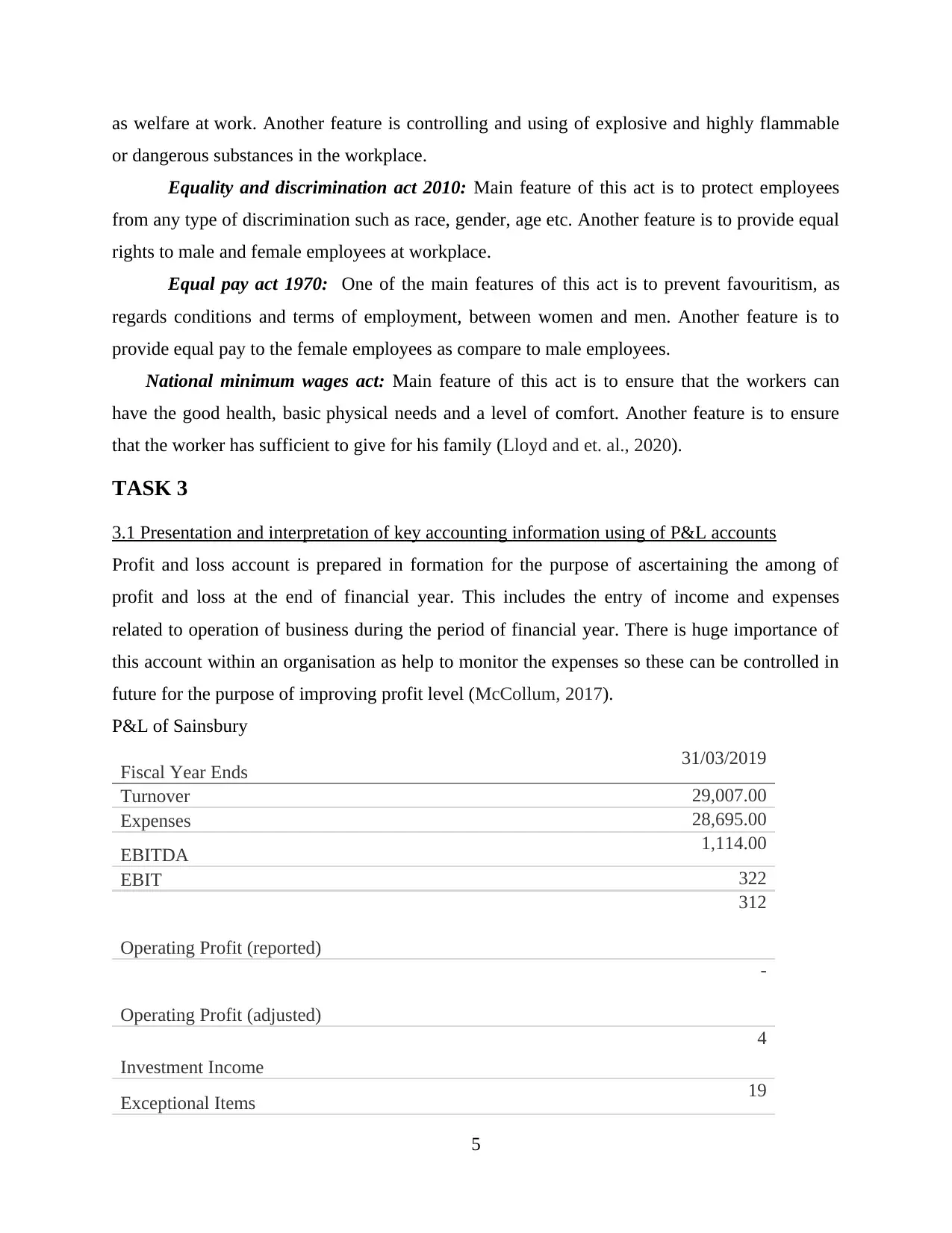
as welfare at work. Another feature is controlling and using of explosive and highly flammable
or dangerous substances in the workplace.
Equality and discrimination act 2010: Main feature of this act is to protect employees
from any type of discrimination such as race, gender, age etc. Another feature is to provide equal
rights to male and female employees at workplace.
Equal pay act 1970: One of the main features of this act is to prevent favouritism, as
regards conditions and terms of employment, between women and men. Another feature is to
provide equal pay to the female employees as compare to male employees.
National minimum wages act: Main feature of this act is to ensure that the workers can
have the good health, basic physical needs and a level of comfort. Another feature is to ensure
that the worker has sufficient to give for his family (Lloyd and et. al., 2020).
TASK 3
3.1 Presentation and interpretation of key accounting information using of P&L accounts
Profit and loss account is prepared in formation for the purpose of ascertaining the among of
profit and loss at the end of financial year. This includes the entry of income and expenses
related to operation of business during the period of financial year. There is huge importance of
this account within an organisation as help to monitor the expenses so these can be controlled in
future for the purpose of improving profit level (McCollum, 2017).
P&L of Sainsbury
Fiscal Year Ends 31/03/2019
Turnover 29,007.00
Expenses 28,695.00
EBITDA 1,114.00
EBIT 322
Operating Profit (reported)
312
Operating Profit (adjusted)
-
Investment Income
4
Exceptional Items 19
5
or dangerous substances in the workplace.
Equality and discrimination act 2010: Main feature of this act is to protect employees
from any type of discrimination such as race, gender, age etc. Another feature is to provide equal
rights to male and female employees at workplace.
Equal pay act 1970: One of the main features of this act is to prevent favouritism, as
regards conditions and terms of employment, between women and men. Another feature is to
provide equal pay to the female employees as compare to male employees.
National minimum wages act: Main feature of this act is to ensure that the workers can
have the good health, basic physical needs and a level of comfort. Another feature is to ensure
that the worker has sufficient to give for his family (Lloyd and et. al., 2020).
TASK 3
3.1 Presentation and interpretation of key accounting information using of P&L accounts
Profit and loss account is prepared in formation for the purpose of ascertaining the among of
profit and loss at the end of financial year. This includes the entry of income and expenses
related to operation of business during the period of financial year. There is huge importance of
this account within an organisation as help to monitor the expenses so these can be controlled in
future for the purpose of improving profit level (McCollum, 2017).
P&L of Sainsbury
Fiscal Year Ends 31/03/2019
Turnover 29,007.00
Expenses 28,695.00
EBITDA 1,114.00
EBIT 322
Operating Profit (reported)
312
Operating Profit (adjusted)
-
Investment Income
4
Exceptional Items 19
5
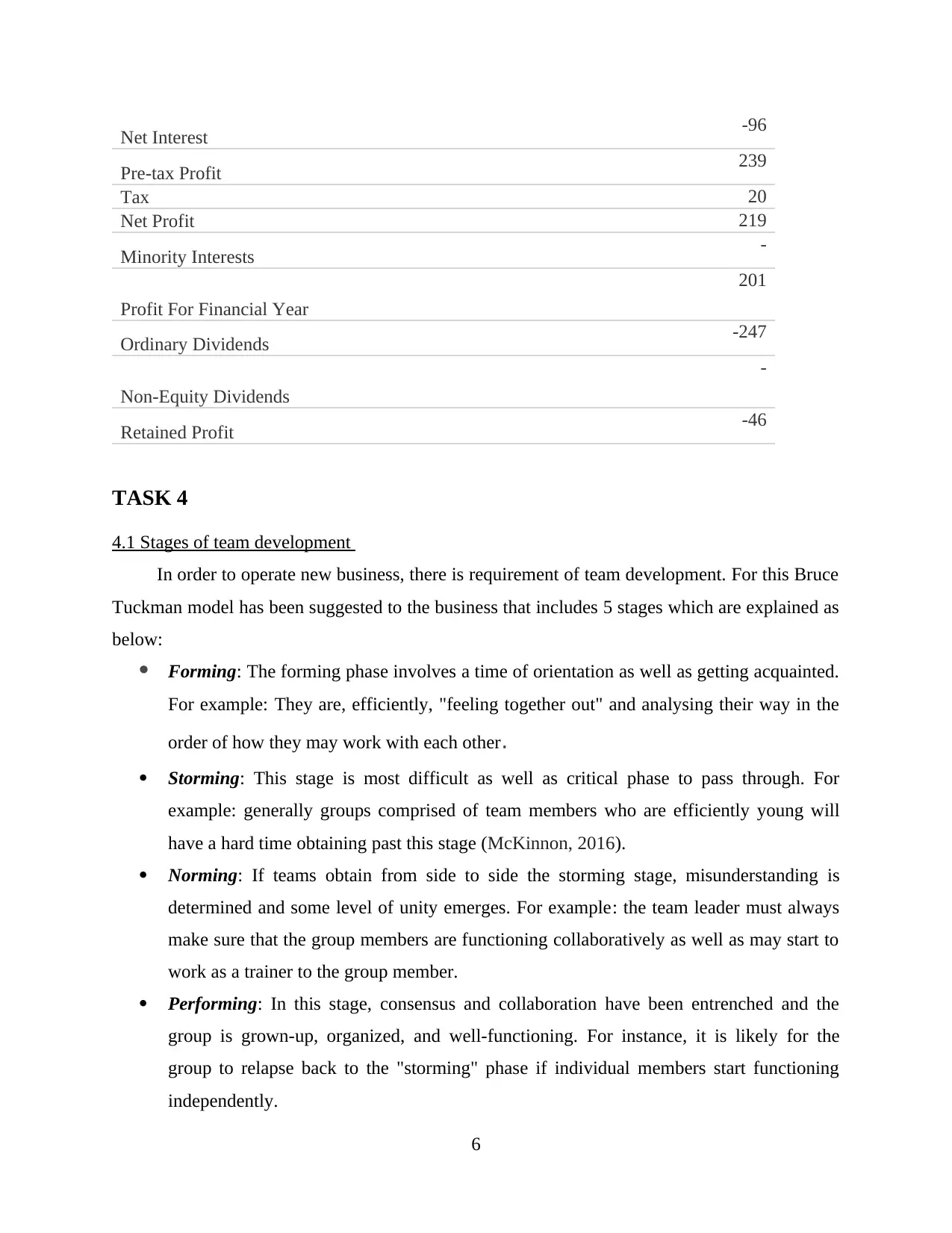
Net Interest -96
Pre-tax Profit 239
Tax 20
Net Profit 219
Minority Interests -
Profit For Financial Year
201
Ordinary Dividends -247
Non-Equity Dividends
-
Retained Profit -46
TASK 4
4.1 Stages of team development
In order to operate new business, there is requirement of team development. For this Bruce
Tuckman model has been suggested to the business that includes 5 stages which are explained as
below:
Forming: The forming phase involves a time of orientation as well as getting acquainted.
For example: They are, efficiently, "feeling together out" and analysing their way in the
order of how they may work with each other.
Storming: This stage is most difficult as well as critical phase to pass through. For
example: generally groups comprised of team members who are efficiently young will
have a hard time obtaining past this stage (McKinnon, 2016).
Norming: If teams obtain from side to side the storming stage, misunderstanding is
determined and some level of unity emerges. For example: the team leader must always
make sure that the group members are functioning collaboratively as well as may start to
work as a trainer to the group member.
Performing: In this stage, consensus and collaboration have been entrenched and the
group is grown-up, organized, and well-functioning. For instance, it is likely for the
group to relapse back to the "storming" phase if individual members start functioning
independently.
6
Pre-tax Profit 239
Tax 20
Net Profit 219
Minority Interests -
Profit For Financial Year
201
Ordinary Dividends -247
Non-Equity Dividends
-
Retained Profit -46
TASK 4
4.1 Stages of team development
In order to operate new business, there is requirement of team development. For this Bruce
Tuckman model has been suggested to the business that includes 5 stages which are explained as
below:
Forming: The forming phase involves a time of orientation as well as getting acquainted.
For example: They are, efficiently, "feeling together out" and analysing their way in the
order of how they may work with each other.
Storming: This stage is most difficult as well as critical phase to pass through. For
example: generally groups comprised of team members who are efficiently young will
have a hard time obtaining past this stage (McKinnon, 2016).
Norming: If teams obtain from side to side the storming stage, misunderstanding is
determined and some level of unity emerges. For example: the team leader must always
make sure that the group members are functioning collaboratively as well as may start to
work as a trainer to the group member.
Performing: In this stage, consensus and collaboration have been entrenched and the
group is grown-up, organized, and well-functioning. For instance, it is likely for the
group to relapse back to the "storming" phase if individual members start functioning
independently.
6
⊘ This is a preview!⊘
Do you want full access?
Subscribe today to unlock all pages.

Trusted by 1+ million students worldwide
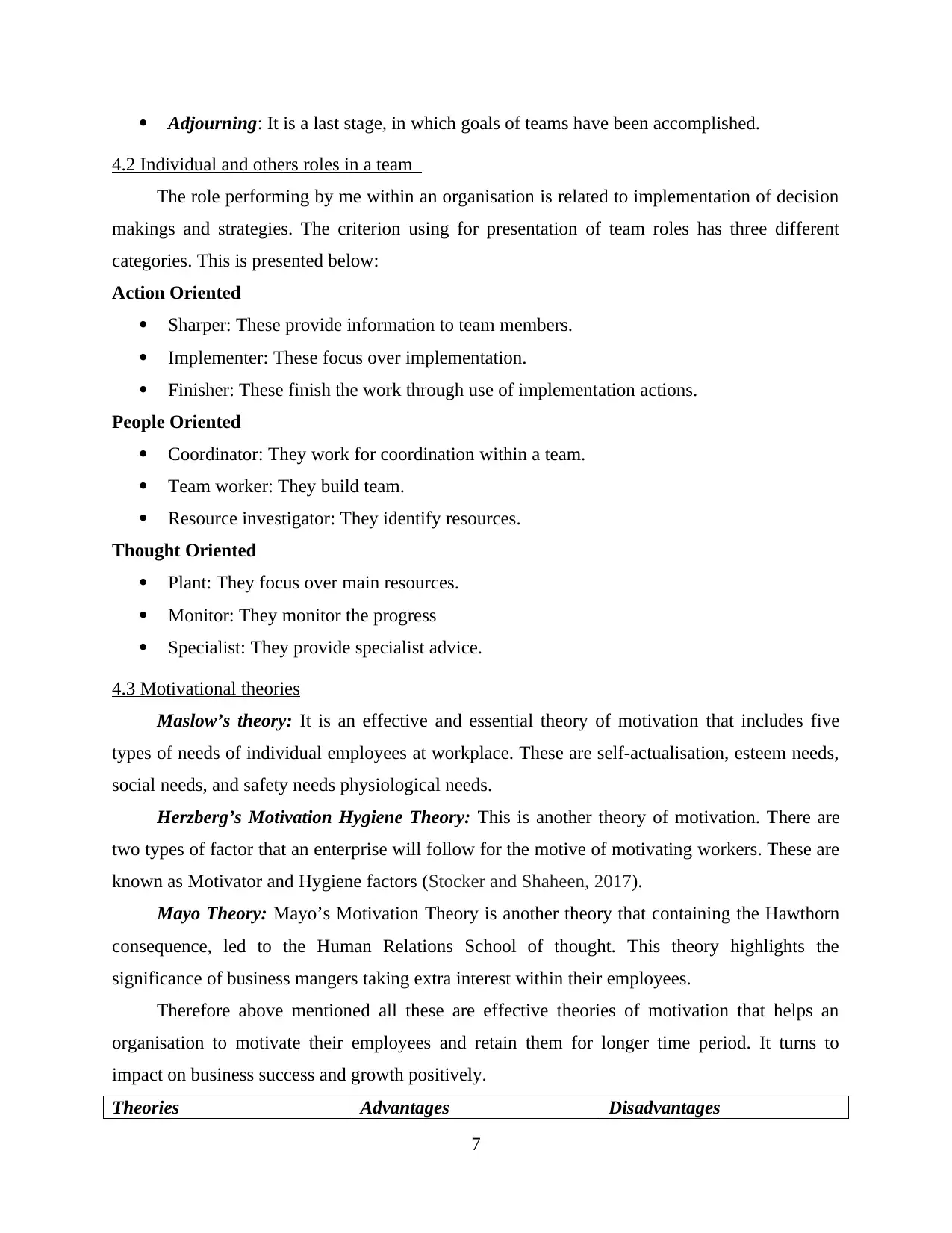
Adjourning: It is a last stage, in which goals of teams have been accomplished.
4.2 Individual and others roles in a team
The role performing by me within an organisation is related to implementation of decision
makings and strategies. The criterion using for presentation of team roles has three different
categories. This is presented below:
Action Oriented
Sharper: These provide information to team members.
Implementer: These focus over implementation.
Finisher: These finish the work through use of implementation actions.
People Oriented
Coordinator: They work for coordination within a team.
Team worker: They build team.
Resource investigator: They identify resources.
Thought Oriented
Plant: They focus over main resources.
Monitor: They monitor the progress
Specialist: They provide specialist advice.
4.3 Motivational theories
Maslow’s theory: It is an effective and essential theory of motivation that includes five
types of needs of individual employees at workplace. These are self-actualisation, esteem needs,
social needs, and safety needs physiological needs.
Herzberg’s Motivation Hygiene Theory: This is another theory of motivation. There are
two types of factor that an enterprise will follow for the motive of motivating workers. These are
known as Motivator and Hygiene factors (Stocker and Shaheen, 2017).
Mayo Theory: Mayo’s Motivation Theory is another theory that containing the Hawthorn
consequence, led to the Human Relations School of thought. This theory highlights the
significance of business mangers taking extra interest within their employees.
Therefore above mentioned all these are effective theories of motivation that helps an
organisation to motivate their employees and retain them for longer time period. It turns to
impact on business success and growth positively.
Theories Advantages Disadvantages
7
4.2 Individual and others roles in a team
The role performing by me within an organisation is related to implementation of decision
makings and strategies. The criterion using for presentation of team roles has three different
categories. This is presented below:
Action Oriented
Sharper: These provide information to team members.
Implementer: These focus over implementation.
Finisher: These finish the work through use of implementation actions.
People Oriented
Coordinator: They work for coordination within a team.
Team worker: They build team.
Resource investigator: They identify resources.
Thought Oriented
Plant: They focus over main resources.
Monitor: They monitor the progress
Specialist: They provide specialist advice.
4.3 Motivational theories
Maslow’s theory: It is an effective and essential theory of motivation that includes five
types of needs of individual employees at workplace. These are self-actualisation, esteem needs,
social needs, and safety needs physiological needs.
Herzberg’s Motivation Hygiene Theory: This is another theory of motivation. There are
two types of factor that an enterprise will follow for the motive of motivating workers. These are
known as Motivator and Hygiene factors (Stocker and Shaheen, 2017).
Mayo Theory: Mayo’s Motivation Theory is another theory that containing the Hawthorn
consequence, led to the Human Relations School of thought. This theory highlights the
significance of business mangers taking extra interest within their employees.
Therefore above mentioned all these are effective theories of motivation that helps an
organisation to motivate their employees and retain them for longer time period. It turns to
impact on business success and growth positively.
Theories Advantages Disadvantages
7
Paraphrase This Document
Need a fresh take? Get an instant paraphrase of this document with our AI Paraphraser
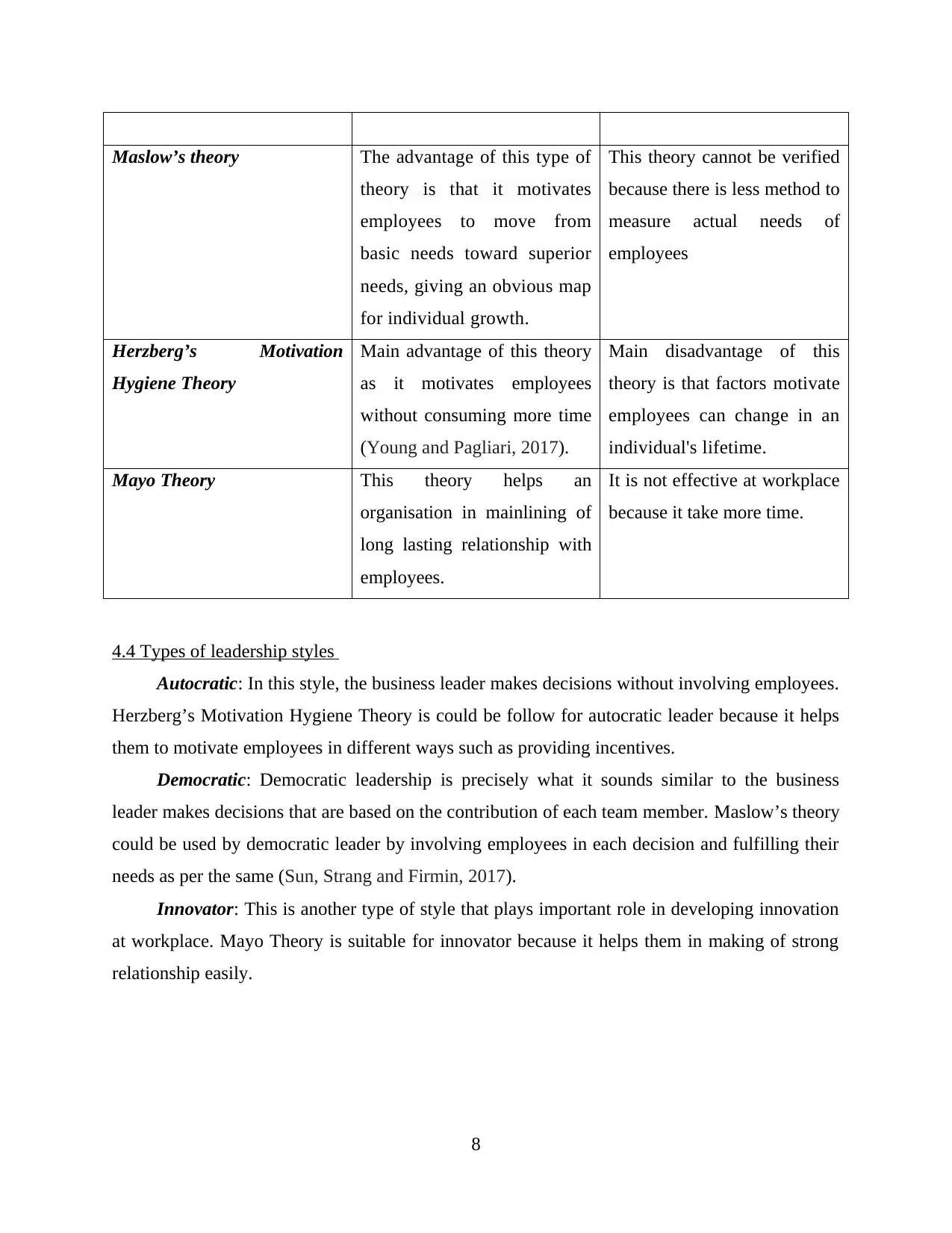
Maslow’s theory The advantage of this type of
theory is that it motivates
employees to move from
basic needs toward superior
needs, giving an obvious map
for individual growth.
This theory cannot be verified
because there is less method to
measure actual needs of
employees
Herzberg’s Motivation
Hygiene Theory
Main advantage of this theory
as it motivates employees
without consuming more time
(Young and Pagliari, 2017).
Main disadvantage of this
theory is that factors motivate
employees can change in an
individual's lifetime.
Mayo Theory This theory helps an
organisation in mainlining of
long lasting relationship with
employees.
It is not effective at workplace
because it take more time.
4.4 Types of leadership styles
Autocratic: In this style, the business leader makes decisions without involving employees.
Herzberg’s Motivation Hygiene Theory is could be follow for autocratic leader because it helps
them to motivate employees in different ways such as providing incentives.
Democratic: Democratic leadership is precisely what it sounds similar to the business
leader makes decisions that are based on the contribution of each team member. Maslow’s theory
could be used by democratic leader by involving employees in each decision and fulfilling their
needs as per the same (Sun, Strang and Firmin, 2017).
Innovator: This is another type of style that plays important role in developing innovation
at workplace. Mayo Theory is suitable for innovator because it helps them in making of strong
relationship easily.
8
theory is that it motivates
employees to move from
basic needs toward superior
needs, giving an obvious map
for individual growth.
This theory cannot be verified
because there is less method to
measure actual needs of
employees
Herzberg’s Motivation
Hygiene Theory
Main advantage of this theory
as it motivates employees
without consuming more time
(Young and Pagliari, 2017).
Main disadvantage of this
theory is that factors motivate
employees can change in an
individual's lifetime.
Mayo Theory This theory helps an
organisation in mainlining of
long lasting relationship with
employees.
It is not effective at workplace
because it take more time.
4.4 Types of leadership styles
Autocratic: In this style, the business leader makes decisions without involving employees.
Herzberg’s Motivation Hygiene Theory is could be follow for autocratic leader because it helps
them to motivate employees in different ways such as providing incentives.
Democratic: Democratic leadership is precisely what it sounds similar to the business
leader makes decisions that are based on the contribution of each team member. Maslow’s theory
could be used by democratic leader by involving employees in each decision and fulfilling their
needs as per the same (Sun, Strang and Firmin, 2017).
Innovator: This is another type of style that plays important role in developing innovation
at workplace. Mayo Theory is suitable for innovator because it helps them in making of strong
relationship easily.
8
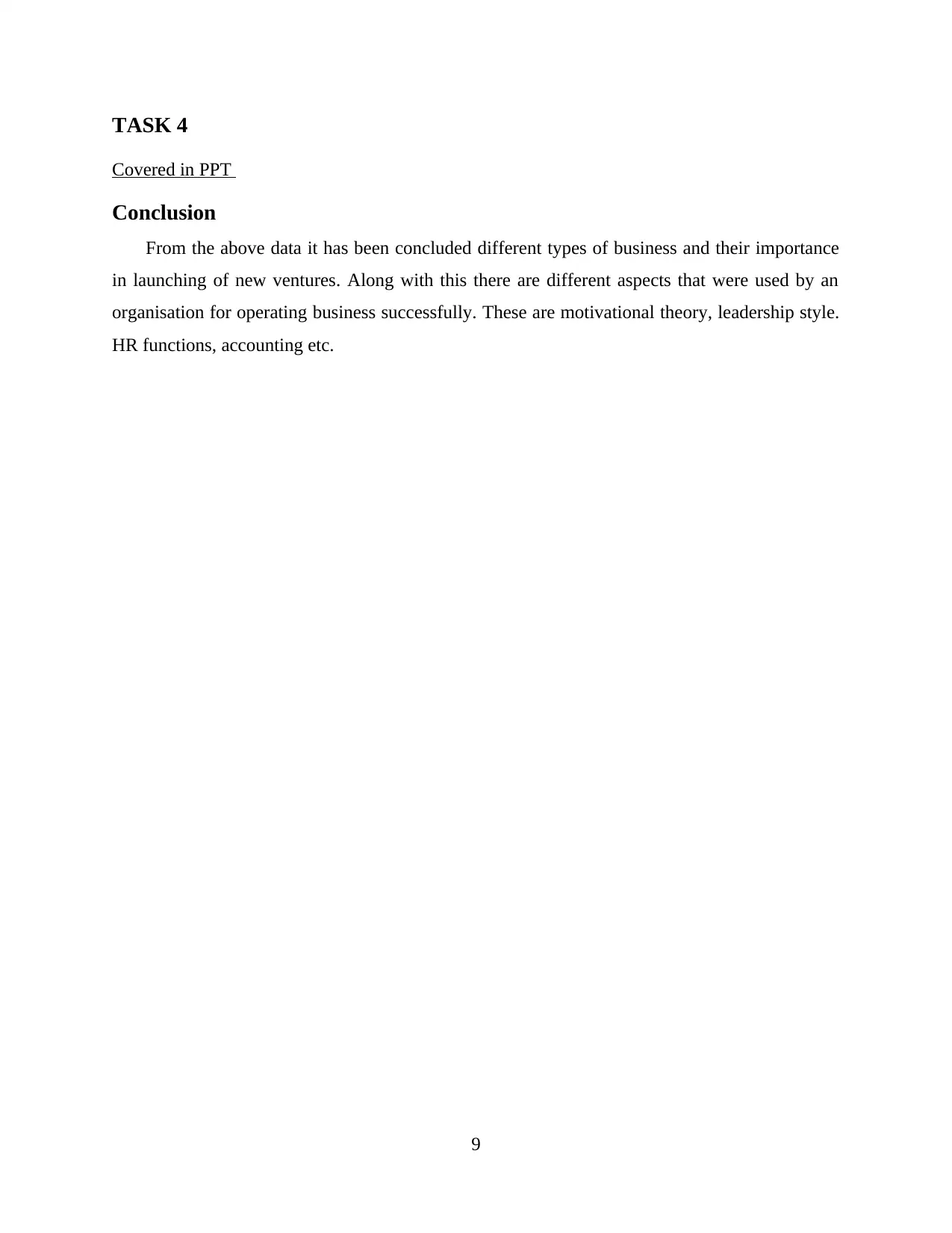
TASK 4
Covered in PPT
Conclusion
From the above data it has been concluded different types of business and their importance
in launching of new ventures. Along with this there are different aspects that were used by an
organisation for operating business successfully. These are motivational theory, leadership style.
HR functions, accounting etc.
9
Covered in PPT
Conclusion
From the above data it has been concluded different types of business and their importance
in launching of new ventures. Along with this there are different aspects that were used by an
organisation for operating business successfully. These are motivational theory, leadership style.
HR functions, accounting etc.
9
⊘ This is a preview!⊘
Do you want full access?
Subscribe today to unlock all pages.

Trusted by 1+ million students worldwide
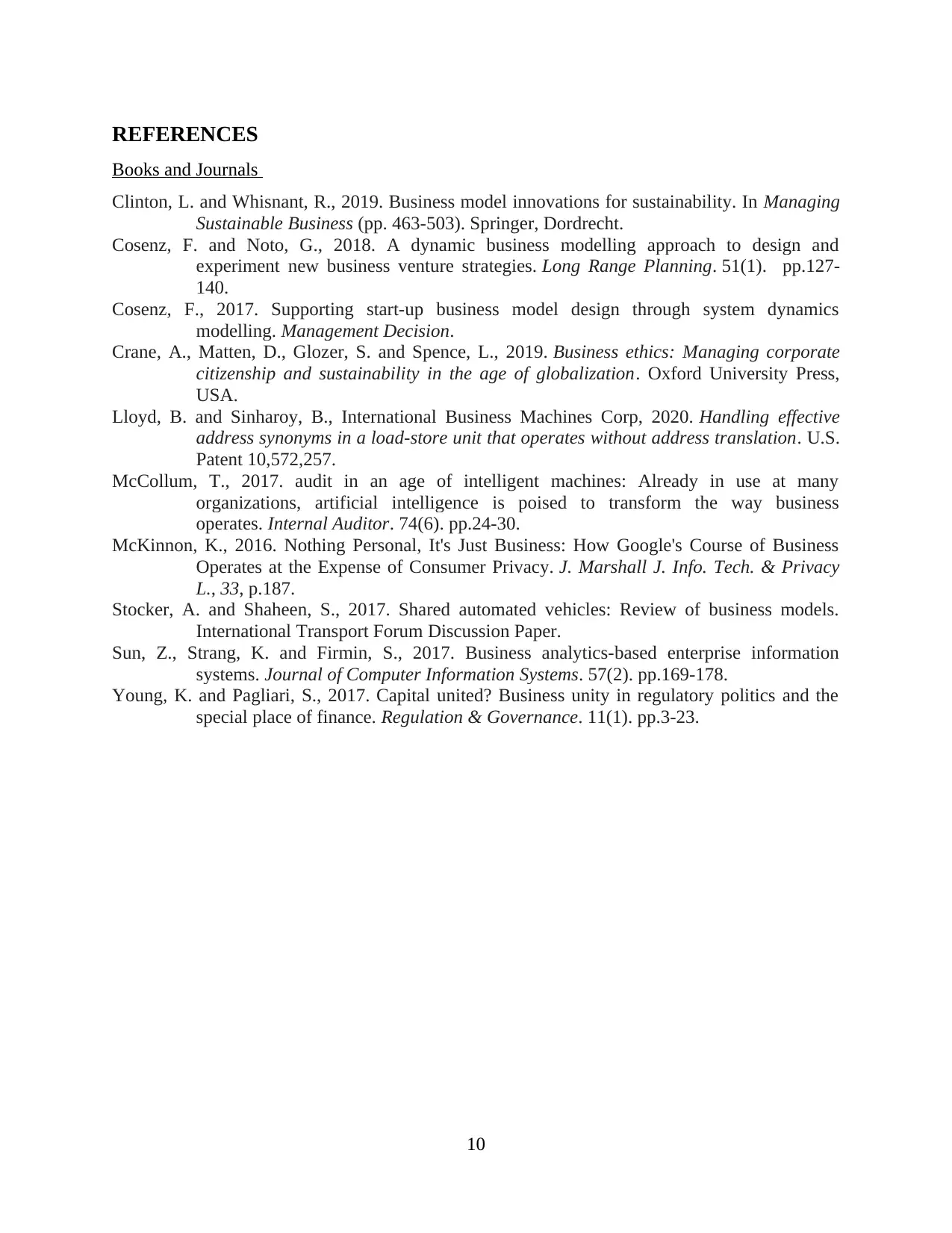
REFERENCES
Books and Journals
Clinton, L. and Whisnant, R., 2019. Business model innovations for sustainability. In Managing
Sustainable Business (pp. 463-503). Springer, Dordrecht.
Cosenz, F. and Noto, G., 2018. A dynamic business modelling approach to design and
experiment new business venture strategies. Long Range Planning. 51(1). pp.127-
140.
Cosenz, F., 2017. Supporting start-up business model design through system dynamics
modelling. Management Decision.
Crane, A., Matten, D., Glozer, S. and Spence, L., 2019. Business ethics: Managing corporate
citizenship and sustainability in the age of globalization. Oxford University Press,
USA.
Lloyd, B. and Sinharoy, B., International Business Machines Corp, 2020. Handling effective
address synonyms in a load-store unit that operates without address translation. U.S.
Patent 10,572,257.
McCollum, T., 2017. audit in an age of intelligent machines: Already in use at many
organizations, artificial intelligence is poised to transform the way business
operates. Internal Auditor. 74(6). pp.24-30.
McKinnon, K., 2016. Nothing Personal, It's Just Business: How Google's Course of Business
Operates at the Expense of Consumer Privacy. J. Marshall J. Info. Tech. & Privacy
L., 33, p.187.
Stocker, A. and Shaheen, S., 2017. Shared automated vehicles: Review of business models.
International Transport Forum Discussion Paper.
Sun, Z., Strang, K. and Firmin, S., 2017. Business analytics-based enterprise information
systems. Journal of Computer Information Systems. 57(2). pp.169-178.
Young, K. and Pagliari, S., 2017. Capital united? Business unity in regulatory politics and the
special place of finance. Regulation & Governance. 11(1). pp.3-23.
10
Books and Journals
Clinton, L. and Whisnant, R., 2019. Business model innovations for sustainability. In Managing
Sustainable Business (pp. 463-503). Springer, Dordrecht.
Cosenz, F. and Noto, G., 2018. A dynamic business modelling approach to design and
experiment new business venture strategies. Long Range Planning. 51(1). pp.127-
140.
Cosenz, F., 2017. Supporting start-up business model design through system dynamics
modelling. Management Decision.
Crane, A., Matten, D., Glozer, S. and Spence, L., 2019. Business ethics: Managing corporate
citizenship and sustainability in the age of globalization. Oxford University Press,
USA.
Lloyd, B. and Sinharoy, B., International Business Machines Corp, 2020. Handling effective
address synonyms in a load-store unit that operates without address translation. U.S.
Patent 10,572,257.
McCollum, T., 2017. audit in an age of intelligent machines: Already in use at many
organizations, artificial intelligence is poised to transform the way business
operates. Internal Auditor. 74(6). pp.24-30.
McKinnon, K., 2016. Nothing Personal, It's Just Business: How Google's Course of Business
Operates at the Expense of Consumer Privacy. J. Marshall J. Info. Tech. & Privacy
L., 33, p.187.
Stocker, A. and Shaheen, S., 2017. Shared automated vehicles: Review of business models.
International Transport Forum Discussion Paper.
Sun, Z., Strang, K. and Firmin, S., 2017. Business analytics-based enterprise information
systems. Journal of Computer Information Systems. 57(2). pp.169-178.
Young, K. and Pagliari, S., 2017. Capital united? Business unity in regulatory politics and the
special place of finance. Regulation & Governance. 11(1). pp.3-23.
10
1 out of 10
Related Documents
Your All-in-One AI-Powered Toolkit for Academic Success.
+13062052269
info@desklib.com
Available 24*7 on WhatsApp / Email
![[object Object]](/_next/static/media/star-bottom.7253800d.svg)
Unlock your academic potential
Copyright © 2020–2025 A2Z Services. All Rights Reserved. Developed and managed by ZUCOL.





